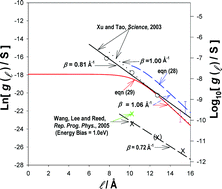Understanding the physical and chemical factors that control the kinetics of interfacial electron-transfer (ET) reactions is important for a large number of technological applications. The present article describes electrochemical kinetic studies of these factors, in which standard interfacial ET rate constants (k0(l)) have been measured for ET between substrate Au electrodes and various redox couples attached to the electrode surfaces by variable lengths (l) of oligomethylene (OM), oligophenylenevinylene (OPV) and oligophenyleneethynylene (OPE) bridges, which were constituents of mixed self-assembled monolayers (SAMs). The k0(l) measurements employed the indirect laser-induced temperature jump (ILIT) technique, which permits the measurement of interfacial ET rates that are orders of magnitude faster than those measurable by conventional techniques using the macroelectrodes that are the most convenient substrates for the mixed SAMs. The robustness of the measured rate constants (k0(l)), together with the Arrhenius activation energies (Ea(l)) and preexponential factors (A(l)), is demonstrated by their invariance with respect to several experimental system parameters (including the chemical nature and length of the diluent component of the mixed SAM). Analysis of the kinetic results demonstrates that all of the observed interfacial ET processes proceed through a common type of transition state (predominantly associated with solvent reorganization around the redox moiety) and that the actual ET step involves direct electronic tunnelling between the Au electrode and the redox moiety. However, for the full range of l investigated, a global exponential decay of A(l) is not found for any of the three types of bridges. Possible reasons for this behavior, including the role of rate determining steps associated with adiabatic mechanisms within or beyond the transition state theory framework, are discussed, and comparisons with related conductance measurements are presented.

You have access to this article
 Please wait while we load your content...
Something went wrong. Try again?
Please wait while we load your content...
Something went wrong. Try again?


 Please wait while we load your content...
Please wait while we load your content...